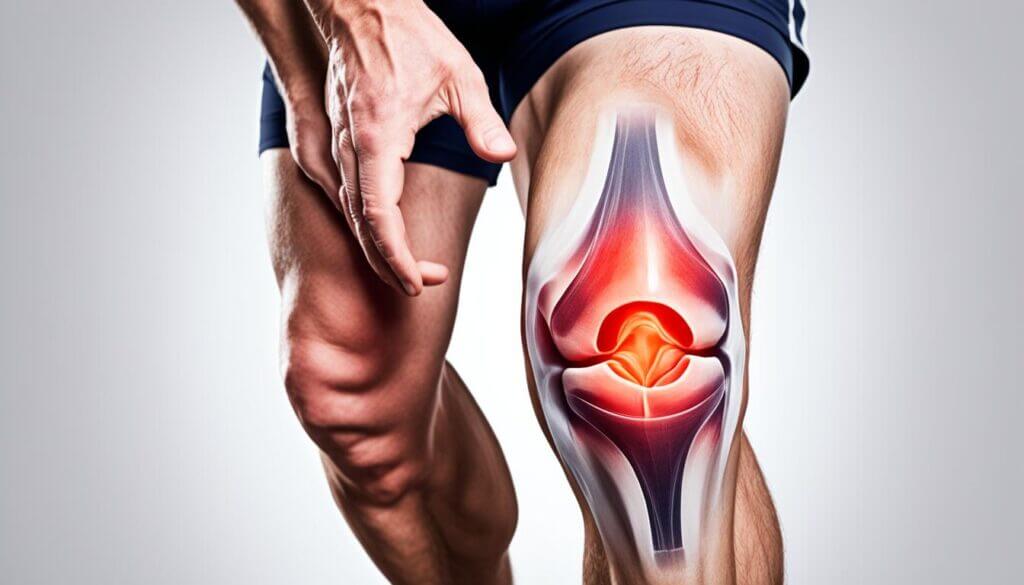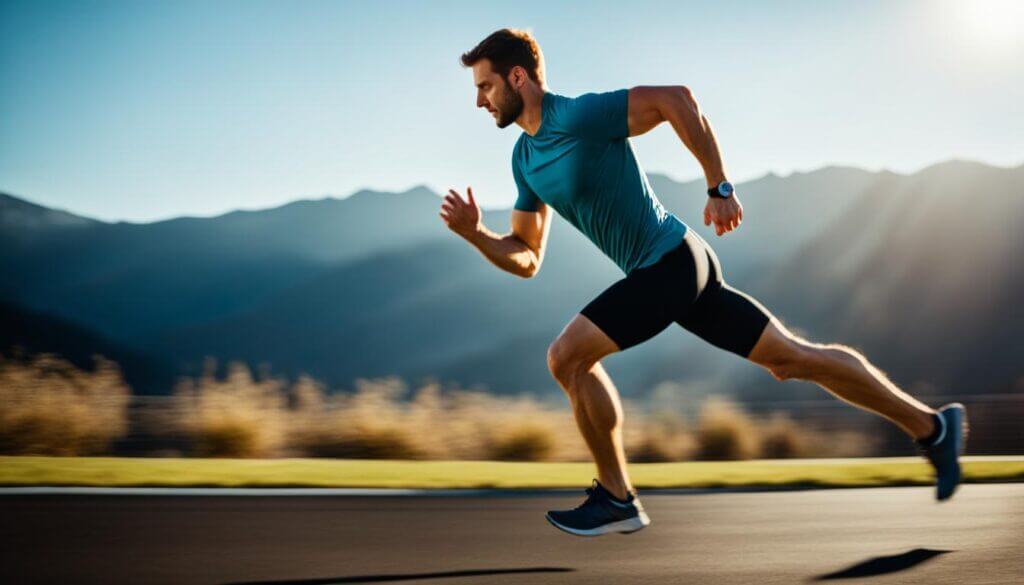As avid runners, we’ve all felt the pain in our knees at some point. But what’s behind that pain, and how can we fix it? Is runner’s knee a normal part of running, or can we prevent and manage it?
Running is a favorite exercise that can affect our knees a lot1. Knee pain from running is common and can come from many things, like overusing our knees, having structural issues, or running the wrong way. Common knee injuries in runners include runner’s knee, IT band syndrome, and jumper’s knee (patellar tendinitis)2. These injuries can cause pain, swelling, stiffness, and make the knee feel unstable. Getting the right treatment, which might mean resting, icing, physical therapy, and sometimes medication or surgery, is key to getting better and avoiding more injuries.
Key Takeaways
- Knee pain is a common issue for runners, with conditions like runner’s knee, IT band syndrome, and jumper’s knee being the most prevalent.
- 1 Runner’s knee, or patellofemoral pain syndrome, can affect up to 30% of female runners and 25% of male runners.
- 3 Runner’s knee is more common in women, particularly those of middle age, and in individuals who are overweight.
- 2 Running-related knee injuries can range from overuse conditions to more serious issues like stress fractures and ligament tears.
- Proper diagnosis, treatment, and prevention strategies are crucial for addressing knee pain and avoiding long-term complications.
What is Patellofemoral Pain Syndrome (Runner’s Knee)?
Patellofemoral pain syndrome, also known as runner’s knee, is a common injury. It causes pain in the front of the knee or around the kneecap4. This pain is often due to a structural issue, bad running habits, or too much training4. People who do sports that make their knees bend a lot, like running, biking, or skiing, are more likely to get this pain5. Women are twice as likely as men to have this knee pain6.
Causes of Patellofemoral Pain Syndrome
There are many reasons for patellofemoral pain syndrome. These include kneecap misalignment, too much training, injury, weak thigh muscles, tight hamstrings, and poor foot support4. Muscle imbalances and injuries also play a big part in this condition6.
Symptoms of Patellofemoral Pain Syndrome
People with runner’s knee may feel pain when they’re active. They might also feel pain after sitting for a long time with bent knees. Some may hear a rubbing, grinding, or clicking in the kneecap, and feel tenderness around it4.
Diagnosing Patellofemoral Pain Syndrome
To diagnose patellofemoral pain syndrome, doctors do a physical exam. They might also use X-rays or MRI scans to check for other possible causes of knee pain4. The doctor will look at how well the knee moves, its strength, and stability to figure out the cause of the pain.
To treat patellofemoral pain syndrome, you might need to rest, use ice, do strengthening exercises, and fix any biomechanical issues4. Losing weight, warming up before exercising, and running correctly can also help prevent and manage this condition6.
| Key Points | Details |
|---|---|
| Definition | Patellofemoral pain syndrome, also known as runner’s knee, is a common overuse injury that causes pain in the front of the knee or around the kneecap4. |
| Causes | Malalignment of the kneecap, excessive training or overuse, injury or trauma, weak thigh muscles, tight hamstrings, poor foot support, and specific walking or running patterns4. |
| Symptoms | Pain during activity, pain after prolonged sitting, rubbing, grinding, or clicking in the kneecap, and tenderness around the kneecap4. |
| Diagnosis | Physical examination, and possibly X-rays or MRI scans to rule out other conditions4. |
| Treatment | Rest, ice, strengthening exercises, and addressing underlying biomechanical issues4. |
| Prevention | Maintaining a healthy weight, warming up before exercise, and using proper running techniques6. |
“Patellofemoral pain syndrome is a complex condition that requires a comprehensive approach to effectively manage and prevent it. Seeking guidance from a healthcare professional is crucial for a proper diagnosis and personalized treatment plan.”
By understanding the causes, symptoms, and treatment options for patellofemoral pain syndrome, runners and active people can prevent and manage this common knee injury. This lets them keep doing their activities with less pain and better knee health.
Other Common Running-Related Knee Injuries
Runners often face knee injuries like iliotibial band syndrome and jumper’s knee, also known as patellar tendinitis. These issues come from overusing muscles, changing training, or running incorrectly. They can make running very uncomfortable and disrupt your routine.
Iliotibial Band Syndrome
Iliotibial band syndrome happens when a tendon from the hip to the outer knee gets tight and hurts. It affects about 12% of runners, making it a common injury7.
Jumper’s Knee (Patellar Tendinitis)
Jumper’s knee, or patellar tendinitis, causes pain and swelling in the tendon connecting the kneecap to the shinbone. It’s more common in young people and starts in their teens or early twenties7.
Like patellofemoral pain syndrome, these injuries come from overusing muscles, changing training, or running wrong. Treatment includes rest, ice, anti-inflammatory drugs, and exercises to help heal.

Other knee injuries in runners can affect the ACL, PCL, collateral ligament, meniscus, cartilage, and tendons. But these are less common than the main injuries7.
To avoid and manage these knee injuries, increase your running slowly, keep good running form, and mix in cross-training and low-impact exercises. Getting medical help quickly and following a full treatment plan helps runners get back to their activities safely.
Knee Pain from Running: Prevention and Treatment Strategies
Dealing with knee pain from running means tackling the root causes and stopping more injuries8. Known as runner’s knee, this pain can stem from overuse, injury, bone misalignment, foot issues, or weak thigh muscles8. About 25-40% of those with runner’s knee feel pain in the kneecap or around it, especially when going downstairs or downhill8. Some may also notice swelling, hear popping sounds, or feel a grinding in their knee.
Fortunately, many cases of runner’s knee can be managed with the right steps8. Treatment includes resting, icing, wrapping the knee, elevating the leg, taking meds, stretching, and doing strengthening exercises8. Most cases get better with proper care, but severe ones might need surgery8. Those with runner’s knee should avoid activities that make it worse until they’re fully recovered.
To stop knee pain from running, focus on the main causes8. Prevention tips include exercising to strengthen thigh muscles, wearing the right shoes, avoiding sudden changes in workouts, and keeping a healthy weight8. To prevent runner’s knee, try using shoe inserts, running on softer ground, warming up, getting physical therapy, wearing knee braces, choosing good running shoes, and replacing old shoes9. Also, doing light weight training and mixing in other cardio can help prevent knee injuries9. Drinking plenty of water is also key for muscle health.
By focusing on knee health, runners can lower their injury risk and keep enjoying this exercise8. Getting advice from a healthcare pro, like a physical therapist or sports medicine expert, can help make a treatment plan that fits your needs.

| Prevention Strategies | Treatment Strategies |
|---|---|
|
|
“Preventing and managing knee pain from running requires a holistic approach that addresses the underlying causes and promotes proper healing.”
Conclusion
Knee pain from running is a common issue. It can come from overuse, structural problems, or running wrong10. Common injuries include runner’s knee, iliotibial band syndrome, and jumper’s knee10. A good plan with rest, treatment, and prevention can help runners overcome these issues10.
Working with health experts and using proven methods helps runners enjoy running more while lowering knee pain and injury risks10. Steps like strength training, foam rolling, and choosing the right shoes can lessen knee problems10. Also, treatments like lubricant injections and PRP can be customized for each runner10.
By knowing what causes knee pain and taking steps to prevent it, runners can keep doing what they love. This approach helps reduce injury risks and keeps runners healthy and happy1011.
FAQ
What is Patellofemoral Pain Syndrome (Runner’s Knee)?
What are the Causes of Patellofemoral Pain Syndrome?
What are the Symptoms of Patellofemoral Pain Syndrome?
How is Patellofemoral Pain Syndrome Diagnosed?
What is Iliotibial Band Syndrome?
What is Jumper’s Knee (Patellar Tendinitis)?
How Can Knee Pain from Running Be Prevented and Treated?
Source Links
- How to Prevent and Treat Runner’s Knee – https://www.runnersworld.com/health-injuries/a20854077/whats-the-best-solution-for-runners-knee/
- Knee Pain After Running: Causes and Treatments – https://www.hss.edu/article_knee-pain-after-running.asp
- Runner’s Knee: Symptoms, Causes, and Treatment – https://www.healthline.com/health/runners-knee
- Patellofemoral Pain Syndrome (Runner’s Knee) – https://www.hopkinsmedicine.org/health/conditions-and-diseases/patellofemoral-pain-syndrome-runners-knee
- Patellofemoral Pain Syndrome (Runner’s Knee) (for Parents) – https://kidshealth.org/en/parents/runners-knee.html
- Patellofemoral pain syndrome – Symptoms and causes – https://www.mayoclinic.org/diseases-conditions/patellofemoral-pain-syndrome/symptoms-causes/syc-20350792
- What Are Common Knee Injuries from Running? – https://www.templehealth.org/about/blog/common-knee-injuries-running
- Runner’s Knee – https://www.webmd.com/pain-management/knee-pain/runners-knee
- Five Tips for Preventing Runner’s Knee – https://www.hss.edu/article_how-to-prevent-runners-knee.asp
- Getting knee pain after your runs? Here’s might be causing it – and how to fix it – https://www.runnersworld.com/uk/health/injury/a773762/4-causes-of-knee-pain-and-how-to-fix-them/
- Anterior knee pain in runners after a half-marathon race – https://www.ncbi.nlm.nih.gov/pmc/articles/PMC8545678/

Leave a Reply